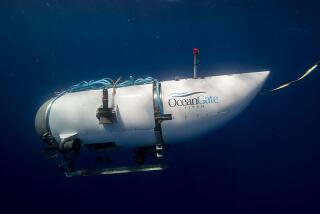Cape Horn’s ferocity is terrifying yet alluring
- Share via
Long before Ken Barnes Jr. tried to sail around Cape Horn, the roaring winds and savage seas in the abyss off the tip of South America brought fear to even the most experienced seamen.
Portuguese explorer Ferdinand Magellan, for example.
“He was dreading doing that,” said author Laurence Bergreen, whose “Over the Edge of the World” tells the story of history’s first circumnavigation of the globe. “He thought it was certain death.”
Instead, in 1520, Magellan found a strait a few hundred miles to the north that bears his name. Even though he would never see Cape Horn, his concern was well founded.
Through the centuries, hundreds of vessels have been swallowed where the Atlantic meets the Pacific, a watery graveyard where deep low-pressure systems power gale-force winds, 100-foot-high rogue waves and summertime blizzards.
Barnes, a 47-year-old Newport Beach man who was expected to be rescued early today near the cape in his crippled 44-foot ketch, can add his name to the lengthy list of adventurers who have felt the fury of one of the planet’s most dangerous places.
Blown off course, Sir Francis Drake took a look at it -- and moved on. The first to make it around was mariner Jacob le Maire, who named it after Hoorn, the Dutch town from which his expedition’s backers hailed. James Cook made it through, but Capt. William Bligh failed with the Bounty.
Cape Horn was deemed so dangerous that the Spanish dragged their plundered gold across land rather than risk shipping it around.
In the 1830s, Richard Henry Dana Jr. kept a diary of his harrowing trip from Boston to California as a sailor on the Pilgrim, which got tossed around Cape Horn like a rubber duck in a washing machine.
“Hurrying upon deck, we found a large black cloud rolling on toward us from the south-west, and blackening the whole heavens. ‘Here comes Cape Horn!’ said the chief mate; and we had hardly time to haul down and clew up, before it was upon us. In a few moments, a heavier sea was raised than I had ever seen before.... At the same time sleet and hail were driving with all fury against us.”
A few years later, people and goods headed for the California Gold Rush turned Cape Horn into a crowded shipping lane where captains feared bumping into one another. The Panama Canal made the passageway an anachronism. In the 1920s, four men rounded the cape in a 42-footer -- generally regarded as the first small boat to accomplish the feat.
Today, Cape Horn has returned to its roots as a magnet for adventure seekers. Some hit the buffet on cruise ships while visiting waters that were once the purview of explorers. Some race yachts through its jaws. Others, such as Barnes, who sold his house and business to finance his lifelong dream, seek to conquer Cape Horn for the same reason climbers scale Mt. Everest.
Because it’s there.
“This place that terrified our ancestors who had to go there is now a place of adventure sailing,” said Dallas Murphy, author of “Rounding the Horn,” which chronicles the cape’s history.
Like Everest, the cape and the surrounding ocean can be deadly unpredictable. Barnes, an experienced sailor awaiting rescue southwest of Chile, knew that going in when he pushed off from Long Beach hoping to circumnavigate the Earth via Cape Horn.
“It’s an epic journey,” said Brad Avery, director of Orange Coast College’s School of Sailing and Seamanship.
“But it’s like any extreme-adventure sport -- it’s a risky thing.”
There’s an old maritime saying: “Below 40 degrees latitude, there is no law. Below 50 degrees, there is no God.”
Cape Horn lies near 56 degrees south latitude -- a place where, when trouble arrives, there is little one can do but pray.
More to Read
Sign up for The Wild
We’ll help you find the best places to hike, bike and run, as well as the perfect silent spots for meditation and yoga.
You may occasionally receive promotional content from the Los Angeles Times.




